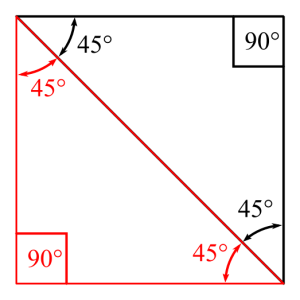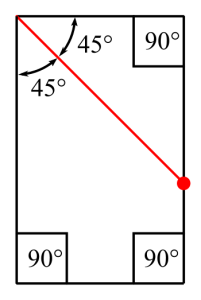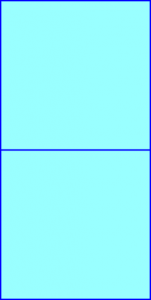THEORY
Although the Application and Training sections will cover the practical aspects of the Angle Detective system, the Theory section is the foundation upon which the other sections are built. This makes it the perfect place to start, but don’t worry about grasping or memorizing everything in this section. I just wanted to set the stage. It can be helpful to know the geometry behind the patterns and other methods taught in the other sections, but it is not essential.
Squares And Rectangles
Look around you. Squares and rectangles shape and compartmentalize much of our lives. We find them in walls, windows, picture frames, floor tiles, cell phones, books, boxes, computer screens, televisions, furniture, billiard tables, chalk cubes and countless other objects. Looking closer we find rectangles within rectangles, squares within squares, rectangles within squares, and squares within rectangles.
What’s So Special About a Square?
Our earliest geometry lessons taught us that a square is a special kind of rectangle where all fours sides have the same length. We will soon see that this special quality makes a seemingly simple square especially special to you and me.
There are other special qualities of a square that we will find useful as well.
A square contains other squares. If we draw lines from the midpoints of a square’s sides to the midpoints of its opposite sides, 4 new interior squares are revealed. Repeating this process with these 4 interior squares reveals 16 new interior squares.
Repeating this process with these 4 interior squares reveals 16 new interior squares. Repeating it again reveals 64 new interior squares. And so on.
Repeating it again reveals 64 new interior squares. And so on. A square also contains special triangles. A straight line drawn from a square’s corner to the opposite corner bisects two of the square’s 90° interior angles revealing four 45° angles and two isosceles (where 2 sides are of equal length) triangles.
A square also contains special triangles. A straight line drawn from a square’s corner to the opposite corner bisects two of the square’s 90° interior angles revealing four 45° angles and two isosceles (where 2 sides are of equal length) triangles.
Is There Anything Special About Ordinary Rectangles?
Yes. Ordinary rectangles are special too.
As in a square, all rectangles contain 4 interior angles that measure 90°. Bisecting any of these 90° angles yields a pair of 45° angles. The big difference is that with a square, the bisecting line runs through two opposite corners, whereas the bisecting line of a non-square rectangle runs through one corner and “somewhere” along one of the rectangle’s opposite sides.  But that “somewhere” is unique to only one rectangle, and this uniqueness makes every rectangle special and useful to us.
But that “somewhere” is unique to only one rectangle, and this uniqueness makes every rectangle special and useful to us.
![]()
However, we will find some rectangles to be more special and useful than others.
The most special is the rectangle that can be created by either the stacking of 2 squares or the halving of 1 square.

But also very special are the rectangles that can be created by:
stacking 4 squares
![]()
Another Special Thing About Squares and Rectangles
A great thing about squares and rectangles (and any other geometric shape for that matter) is that they retain their proportions no matter what their size. For example, the 23mm by 23mm square bottom face of a cube of chalk has the same proportions and hidden interior angles as a 90ft. by 90ft. baseball diamond or the 15in. by 15in. first, second or third bases on that baseball diamond.
Similarly, the rectangular proportions of a 16:9 aspect ratio YouTube video remain the same whether we’re watching it on a 4” cell phone or a 100” wide-screen TV.
The fixed proportion inherent to geometric shapes is a beautiful thing. It allows us to scale them up or scale them down without changing the relationships of their structural elements.
So what if their structural elements included balls, pockets and sight lines?



